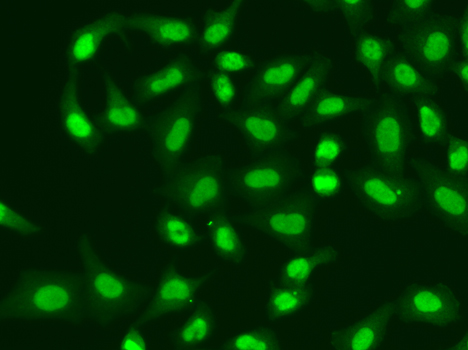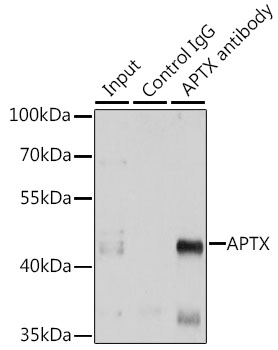-
Product Name
APTX Polyclonal Antibody
- Documents
-
Description
Polyclonal antibody to APTX
-
Tested applications
WB, IF, IP
-
Species reactivity
Human, Mouse
-
Alternative names
APTX antibody; AOA antibody; AOA1 antibody; AXA1 antibody; EAOH antibody; EOAHA antibody; FHA-HIT antibody; aprataxin antibody
-
Isotype
Rabbit IgG
-
Preparation
Antigen: Recombinant fusion protein containing a sequence corresponding to amino acids 93-342 of human APTX (NP_001182178.1).
-
Clonality
Polyclonal
-
Formulation
PBS with 0.02% sodium azide, 50% glycerol, pH7.3.
-
Storage instructions
Store at -20℃. Avoid freeze / thaw cycles.
-
Applications
WB 1:500 - 1:2000
IF 1:50 - 1:100
IP 1:20 - 1:50 -
Validations

Western blot - APTX Polyclonal Antibody
Western blot analysis of extracts of various cell lines, using APTX antibody at 1:1000 dilution.Secondary antibody: HRP Goat Anti-Rabbit IgG (H+L) at 1:10000 dilution.Lysates/proteins: 25ug per lane.Blocking buffer: 3% nonfat dry milk in TBST.

Immunofluorescence - APTX Polyclonal Antibody
Immunofluorescence analysis of A549 cells using APTX antibody .

Immunoprecipitation - APTX Polyclonal Antibody
Immunoprecipitation analysis of 150ug extracts of A549 cells using 3ug APTX antibody . Western blot was performed from the immunoprecipitate using APTX antibody at a dilition of 1:500.
-
Background
DNA-binding protein involved in single-strand DNA break repair, double-strand DNA break repair and base excision repair. Resolves abortive DNA ligation intermediates formed either at base excision sites, or when DNA ligases attempt to repair non-ligatable breaks induced by reactive oxygen species. Catalyzes the release of adenylate groups covalently linked to 5'-phosphate termini, resulting in the production of 5'-phosphate termini that can be efficiently rejoined. Also able to hydrolyze adenosine 5'-monophosphoramidate (AMP-NH(2)) and diadenosine tetraphosphate (AppppA), but with lower catalytic activity. Likewise, catalyzes the release of 3'-linked guanosine (DNAppG) and inosine (DNAppI) from DNA, but has higher specific activity with 5'-linked adenosine (AppDNA) (By similarity).
Related Products / Services
Please note: All products are "FOR RESEARCH USE ONLY AND ARE NOT INTENDED FOR DIAGNOSTIC OR THERAPEUTIC USE"
